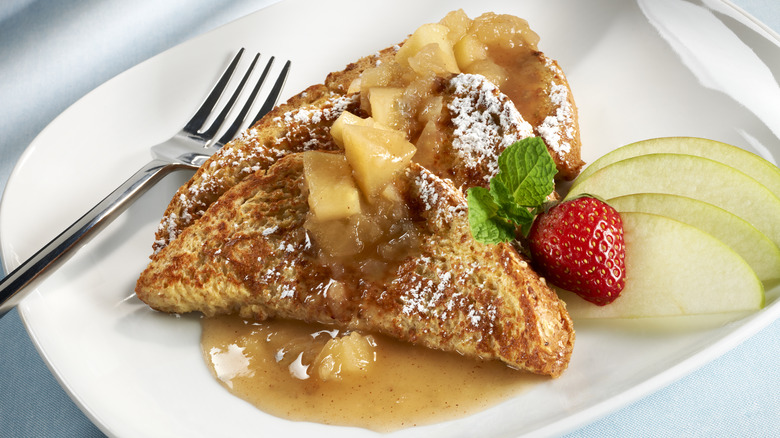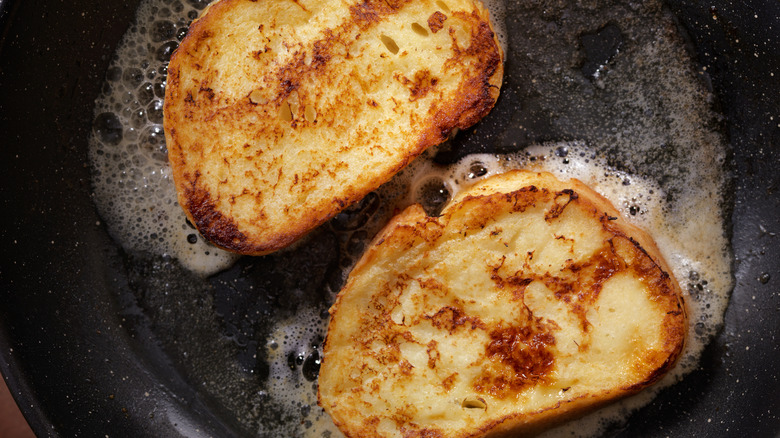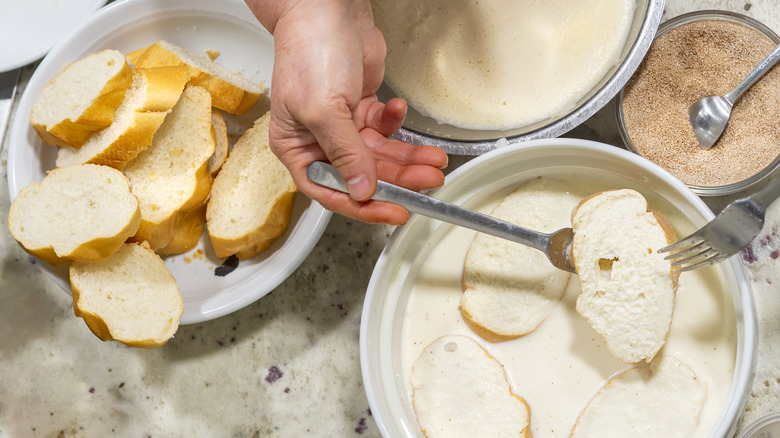This Savory Ingredient Is The Key To Elevated French Toast
French toast typically lands in the sweet category for breakfast, as opposed to egg-based dishes with veggies, cheeses, or proteins. But one savory ingredient will elevate your French toast every time: Olive oil. Combine olive oil with butter when you pan-fry or griddle your slices and never look back.
Many home cooks consider butter the go-to ingredient for this job, but chefs often use it with olive oil. As they're both fats, they perform similar functions, but you get a flavor boost with olive oil. And if it seems like a savory ingredient is out of place in a sweet dish, there's science to prove that this works. Flavor layering savory with sweetness keeps our palates happy and craving more. Many olive oils have profiles that can range from grassy, peppery, and herbaceous, which are perfect for this flavor layering process when paired with sweet notes of custardy French toast, a dusting of powdered sugar, or a drizzle of maple syrup.
The combination also helps to develop taste and texture. While it is a myth that adding oil mitigates the smoke point of butter, it does help to inhibit your butter from browning as fast. That means you can cook your toast a little longer (over medium-low heat since you're not lowering the smoke point), allowing your batter to crisp up and caramelize while the aromas and flavors of both fats bloom.
The qualities and flavors of olive oil
Olive oil is a broad category, but for French toast, we want flavor, which means focusing on extra virgin (EVOO), rather than virgin, light, or pure. This designation indicates "first press" or the first time the oil has been extracted from the fruit. This is usually done at low temperatures (often called cold-pressed) to preserve integrity in terms of flavor and nutritional qualities and translates to a more robust, less obfuscated taste.
From there, you can narrow your oil selection by considering your place of origin. Spanish EVOO may be more fruit-forward, while Italian could pack a more herbal essence. That said, many factors impact the flavor and aroma of your oil, so it's helpful to taste beforehand to determine which will be best for your type of toast. For example, Spanish-style torrijas is a French toast-like dish made with sweetened condensed milk. Given the intense sweetness, an oil with a subtle peppery character and a touch of bitterness would be a great balancing element.
You can even use infused oils to add an extra pop. For example, an orange-infused oil would pair well with the cinnamon usually called for in French toast recipes (or even a dose of Grand Marnier). In contrast, a vanilla-infused olive oil would be a serious kicker for churro French toast.
More French toast tips
Starting with something like an easy brioche French toast recipe gives you a fairly neutral canvas for customization. You can change up the core elements like your dairy or spices, while toppings beyond maple syrup can add an extra dimension. The addition of EVOO gives you even more ways to manipulate the flavor since it offers a range of profiles.
Some olive oils have notes of banana or apple, which complement caramelized bananas foster or apple cinnamon French toast. Alternatively, you can go for a sharp, pungent, and peppery oil that will be a counterpoint to sweet or fruity flavors. Chocolate is also a natural partner for olive oil, so you can incorporate cocoa into your batter, or sprinkle your slices with chocolate chips and dust with powdered sugar.
You can even double down on olive oil in this dish, not only cooking your French toast in it but using it as a topping. Skip the maple syrup and pour a drizzle of fresh EVOO over the top, and when you can get your hands on fresh berries, pile those on, too. There are plenty of excellent French toast hacks you might not know about, but this olive oil addition elevates French toast in multiple ways.


